The Knowledge Pool — Kydele & Thrasios Part 2
Hi everyone! Welcome back to the Knowledge Pool. This week we will be doing a continuation of our series on Kydele & Thrasios as commanders of a UG combo style deck. If you have not yet read Part 1, I strongly encourage that you do so. Part 1 can be found here.
Efficient Evolution

Last time I explored my personal Kydele & Thrasios deck, and I identified the shortcomings it demonstrated. I pointed out that I hadn't built my deck efficiently enough, and that I hadn't made a clear enough focus on the deck's intended themes. Since writing the previous article I've reconsidered which direction to take this deck, ultimately deciding to focus on two characteristics: acceleration and efficient draw. While this is not a novel approach to this style of deck building, I feel like it will help us reach the deck's goals: draw lots of cards to fuel Kydele, and then use the mana generated from Kydele or my other ramp sources to generate an infinite interaction.
A Pursuit of Growth and Knowledge
My previous design was built with more typical Commander theory in mind, and one area where this style of deck building failed was our ramp package. I included cards like Cultivate and Kodama's Reach, and I also included a "lands matter" package with cards like Exploration and Azusa, Lost but Seeking. These are normally great options for a ramp deck in the UG combination, however they fail to synergize with our commander, and the proved too slow to allow us to consistently and efficiently reach an infinite interaction. With these deficiencies in mind, we need to adjust our ramp package with an aim towards cheaper options that can help us ensure that we're ramping from turn 1.
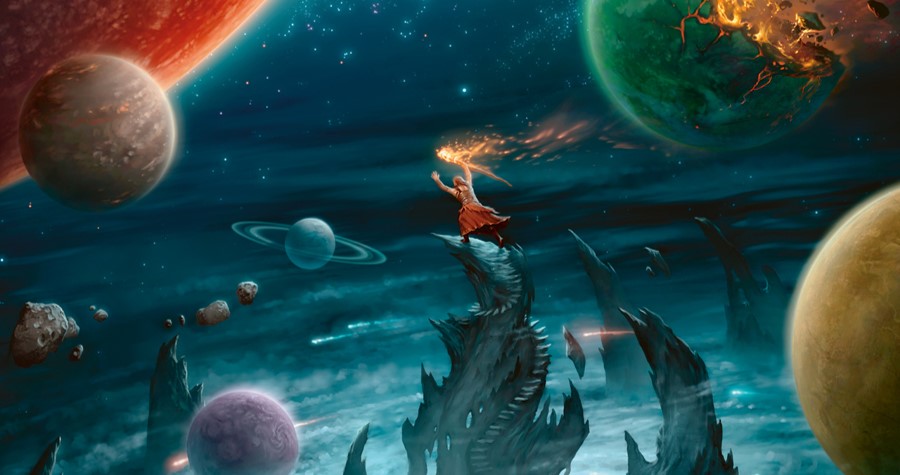
The draw spells I included in the previous deck were also lacking. I focused too much on being able to draw lots of cards all at once, without worrying about cost considerations. Big spells like Time Reversal and Recurring Insight appear to to synergize really well with Kydele, but often drawing 7 cards is overkill for our combos. I also neglected spells that let us "filter" our draws, in favor of cards that included the phrase "draw a card". I want to shy away from the bigger draw spells, and narrow our options to spells that will allow us to dig deeper towards the cards we need so that we can make the most of each card draw.
Finally, I have not purged all of the untap abilities I originally included in this deck. I feel like the more potent ones, like Paradox Engine, will help us to make the most of our efficient ramp package.
Let's take a look at where I ended up with my list:
The Hot Takes

If you remember my previous build, this deck should look strikingly different. I've swapped out roughly 30 cards, and as a result our curve has dropped from ~3.00 to 2.30. Shrinking our curve in this way is invaluable as far as efficiency is concerned. We have 14 spells, not including Thrasios, that are dedicated to digging deeper in our deck, and our "big" draw spells top out at 4 mana with Jace, the Mind Sculptor. We have 17 spells, not including Kydele, that are dedicated towards ramp, and of these only three cost 3 or more. This means that ~30% of our deck is directly dedicated towards finding and casting our win condition spells. Let's take a closer look at what makes this deck "tick".
Acceleration
The Dorky Side of Commander
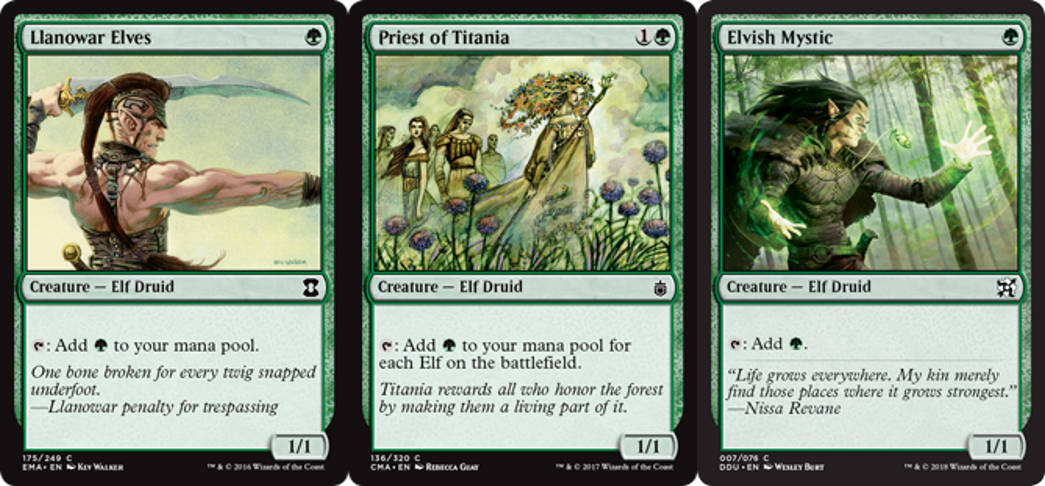
I decided to make our ramp package a split between mana dorks and mana rocks. The dorks seem valuable for their cheap cost, and like our mana rocks, they will go infinite if we have a density of them and an effect that can untap multiple permanents. With the dorks, we now have 8 one-mana ramp spells, giving us a decent chance to have a turn 1 play. Also, given that we have 5 elvish dorks, I decided to include Priest of Titania. In the worst case scenarios, Priest will be able to ramp us one mana for our two mana investment. At best, it will tap for several mana, turning into very efficient ramp source.
With the inclusion of dorks, we can now also include Green Sun's Zenith and Dryad Arbor. On turn two, Zenith will find us a dork to ensure our acceleration, and on turn one, Zenith will find Arbor. While Zenith will almost always be finding dorks, it's important to note that it can find us Eternal Witness if we lose a combo piece or Magus of the Candelabra if we need to "filter" our mana.
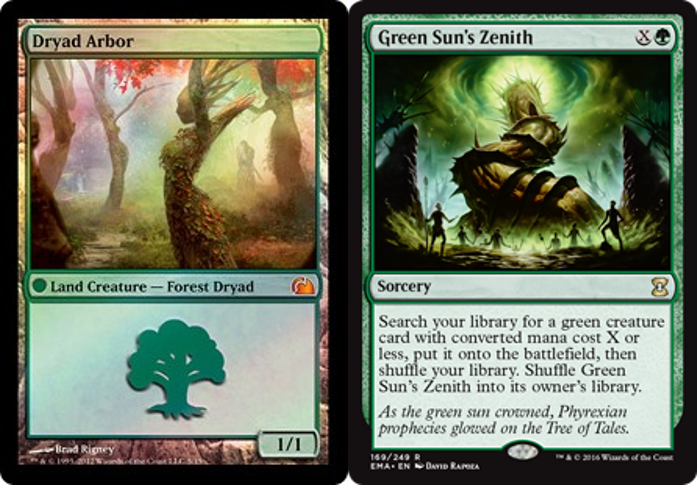
The cheap dorks don't come without their downsides, however. First, unlike the mana rocks, our dorks are much more likely to be swept up in a wrath. This makes them rather fragile, and means we will need to try and get our use of them before they inevitably find their way to the graveyard. Second, mana dorks, specifically elves, tend to cost and make green mana, and while roughly 1/3 of the costs in the deck are green, this means that our dorks will be less helpful for casting our draw and counter spells. Moreover, this means that our manabase must be skewed towards green if we hope to be able to play one of our 1 drops dorks on turn 1 consistently. These concerns being addressed, I still think we can manipulate our mana to accommodate the dorks, and with 1/5 of the deck being comprised of artifact spells and a handful of colorless mana sink options (like Helix Pinnacle), we shouldn't have an issue putting our dorks to good use.
Solid as a Rock
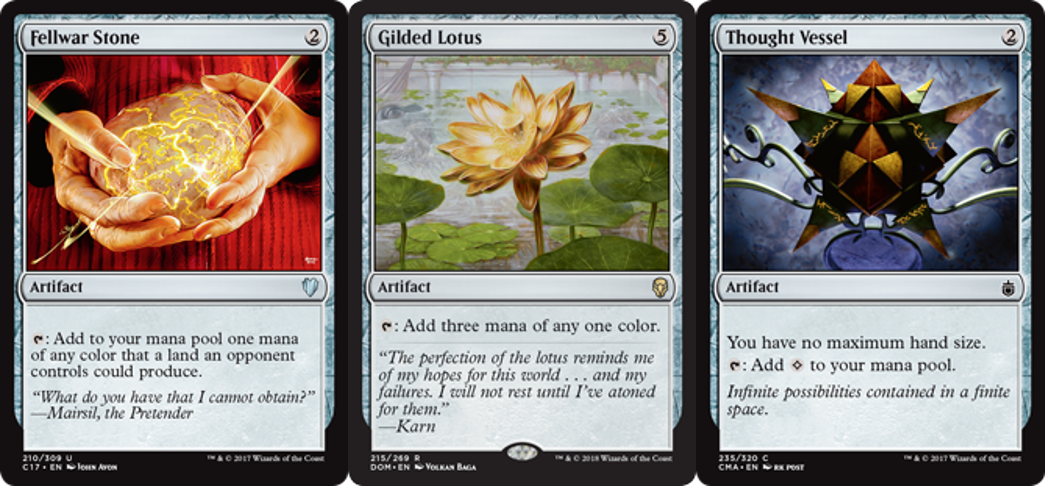
Now let's briefly cover the mana rocks. This is one portion of the deck that didn't get a massive overhaul in comparison to the previous list; however, I did still add Fellwar Stone, Mind Stone, and Thought Vessel. I chose to leave in our bigger rocks like Thran Dynamo and Gilded Lotus because of how much extra value we can get from untapping them. While our rocks tend to cost a bit more than our dorks, they will also be more resilient, not getting hit by as many of the traditional board wipes.
I would like to add a final caveat to the discussion of acceleration. It's possible that this deck should remove dorks in exchange for cards like Chrome Mox, Mox Diamond, Mox Opal, Mox Amber, and Grim Monolith. This would make our entire ramp package cheaper and less susceptible to removal. However, most of moxen have downsides that limit their consistency, and while these can be navigated, I chose dorks over these options for consistency's sake.
Efficient Card Draw
The Legacy Special
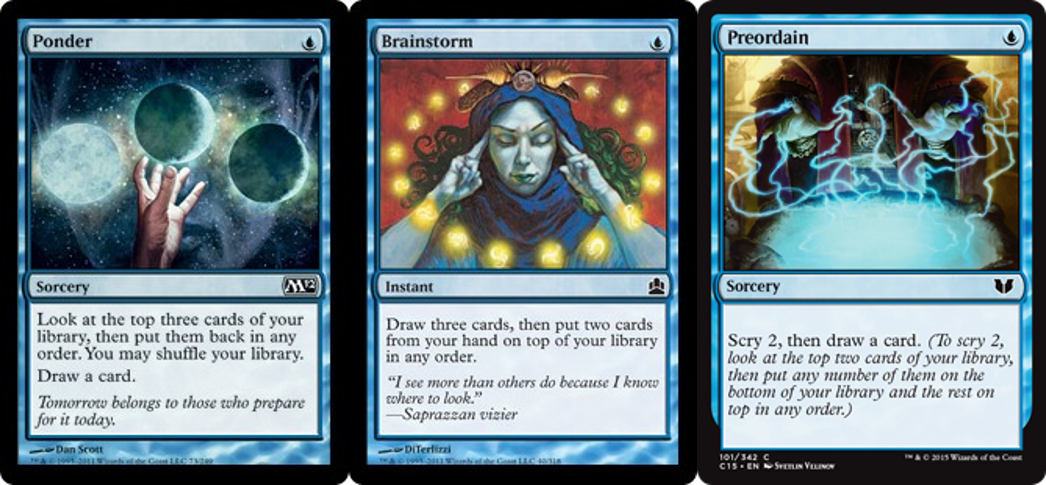
In formats like Modern and Legacy, cantrips are one of Blue's biggest advantages. The opportunity to dig deeper into your deck and effectively "filter" your card draw is a method employed by combo decks in all constructed formats. In Commander, one use cantrips like Ponder and Preordain are less common. While these cards are still quite powerful in Commander, many players, myself included, are discouraged by their one-time nature. My previous build included cards like Teferi's Puzzle Box and Forgotten Creation because they offered a consistent effect over multiple turns. However, after some consideration, I feel that this deck wants the cantrips.
We have 4 one-mana spells that allow us to draw a card while manipulating the cards we draw on successive turns. In the early game these spells help us smooth out our ramp and our fixing, and later game they dig us to the combo pieces we need. The ceiling on these cards is low, but the floor is very high. At worst, these will be effectively "free" with Kydele on board thanks to the magic words: "draw a card". Gitaxian Probe is a slightly different case as it does not afford us the same "digging" power that the other three cantrips do. However, anyone who's familiar with Modern or Legacy will be aware of just how nice it can be to play this card for free. Probe effectively costs zero unless we're in the most dire of situations, and essentially allows us to build our deck with 99 cards. Early on, casting Probe will let us cycle, and later game it will let us see the potential answers our opponents may have. These 5 cantrips add a storm-like quality to the deck. We won't be drawing all the cards to boost Kydele with one spell, but with a handful of cheaper spells.
Cheap Gas
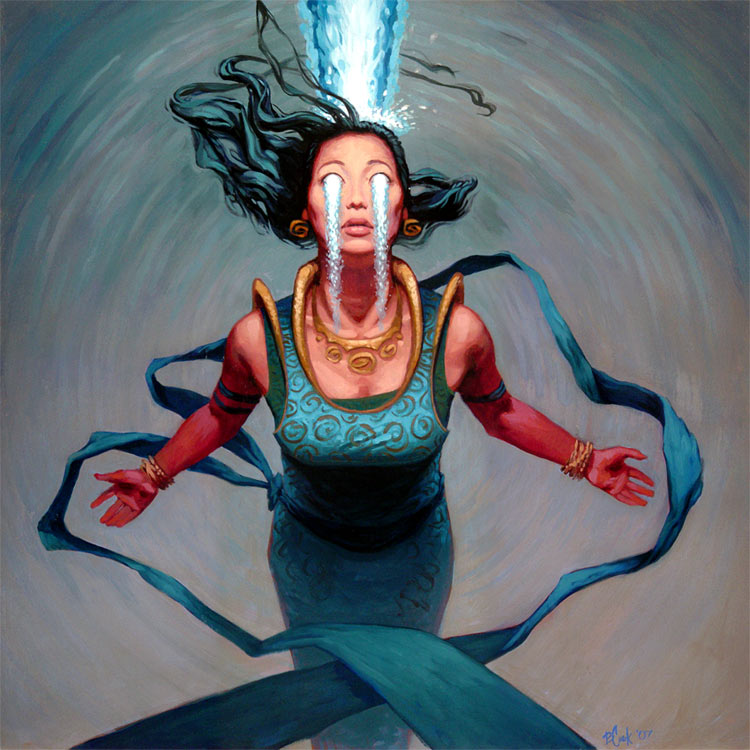
Moving beyond the cantrips, I've included Tolarian Winds, Frantic Search, Stroke of Genius, and Thirst for Knowledge. Winds is card disadvantage, but the opportunity to draw 3-4 cards and put Kydele into combo range is appealing. The fact that it's instant means that it has far greater utility, and could be useful to us if we're trying to dig for an answer on an opponent's turn. Instant speed also becomes much more appealing when we consider that Isochron Scepter is now in this deck. If we imprint either Brainstorm or Winds with Scepter, we have the opportunity to see a lot of cards in our deck with very little investment. I've included Search in this list because, even though it's card disadvantage, its untap ability will give us a "free" way to draw cards. Thirst was included because it represents one of the best rates available to us for drawing cards, and with the high density of artifacts in our build, the discard cost will be negligible in most situations. Finally, I briefly touched on Stroke in my previous article, and how it's a clear upgrade to Pull from Tomorrow in this build. The fact that it requires less blue mana investment, and has the ability to mill an opponent out makes it a powerful option.
Before we move forward, I want to point out that Gush could potentially be a very good card in this deck, offering us similar combo potential to Frantic Search. This is one of the first cards I will try swapping in if a card in this deck is under-performing.
An Efficient Machine
The Big Mana Payoff
I promised that I would highlight a few of the combos in this deck in this article. My gut feeling is that this is the kind of deck where there are a wide variety of potentially convoluted combos are possible, so I will stick with with ones I've intentionally built into this deck. Feel free to let me know if there are any I've missed!
Most of our combos revolve around infinite mana. This may seem obvious, given the emphasis I've placed on Kydele during this building process, but it's worth reiterating because it influences the combo win conditions we choose, the back-up combos we include, and the deck's alternative (non-combo) win conditions.
Queen Bee
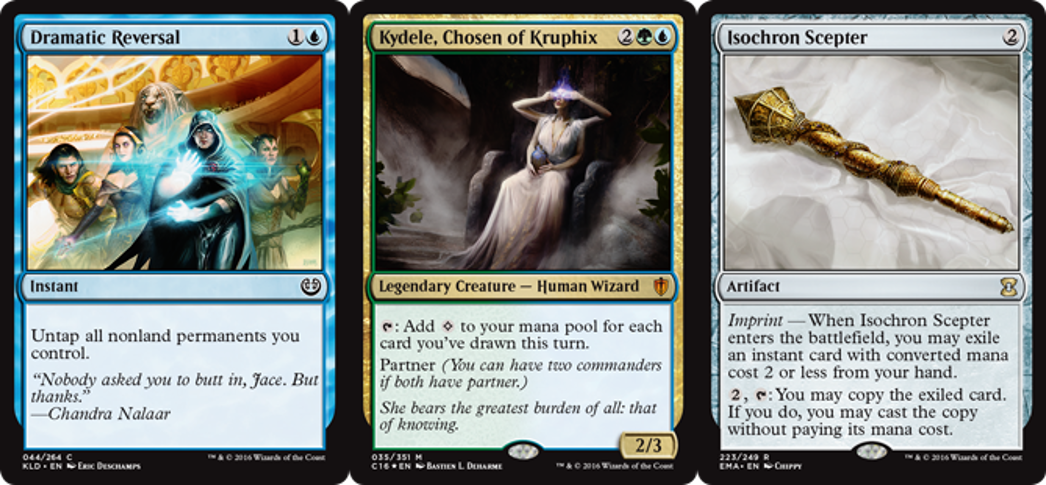
First let's start with our primary targets: Kydele + drawing 4 or 5 cards + infinite untaps. We've already talked about our draw options in depth, but for our "infinite untaps" the options are Staff of Domination, Sword of the Paruns, and Umbral Mantle. Mantle and Sword both only require us to have drawn 4 cards to net one additional mana with Kydele with each untap. Staff requires 5 cards, but comes with the added bonus of being a two card combo with Kydele. Once we've generated infinite mana with Kydele, we can use Staff to draw our entire deck and find a win condition. It's worth noting that beyond simply drawing into one of these pieces, Trophy Mage will find Mantle or Staff, and Fabricate and Tezzeret the Seeker will find any of them.
Next, we have a back-up means of generating infinite mana: Isochron Scepter + Dramatic Reversal + any combination of rocks, dorks, or Kydele making 3 or more mana. An added benefit of this particular combo is that by untapping dorks and rocks, we have the potential to generate infinite colored mana. While most of our mana sinks require colorless mana, we will need U or G to cast most of our spells. It should be noted that in addition to Fabricate and Tezzeret the Seeker, Muddle the Mixture can be transmuted to find either Reversal or Scepter.
Other Scepter combos are possible without Reversal: Isochron Scepter + any imprinted spell + Paradox Engine + any combination of rocks, dorks, or Kydele making 3 or more mana. This interaction also results in infinite mana.
Finally, I want to acknowledge Mana Reflection. Reflection essentially cuts all of our costs in half, allowing Kydele to generate infinite mana with Mantle or Sword after only drawing two cards and with Staff after drawing three cards. It also combos with Basalt Monolith to generate infinite colorless mana.
So now we have infinite mana. What can we do with it? That's where the mana-sinks come into play.
Enter The Infinite
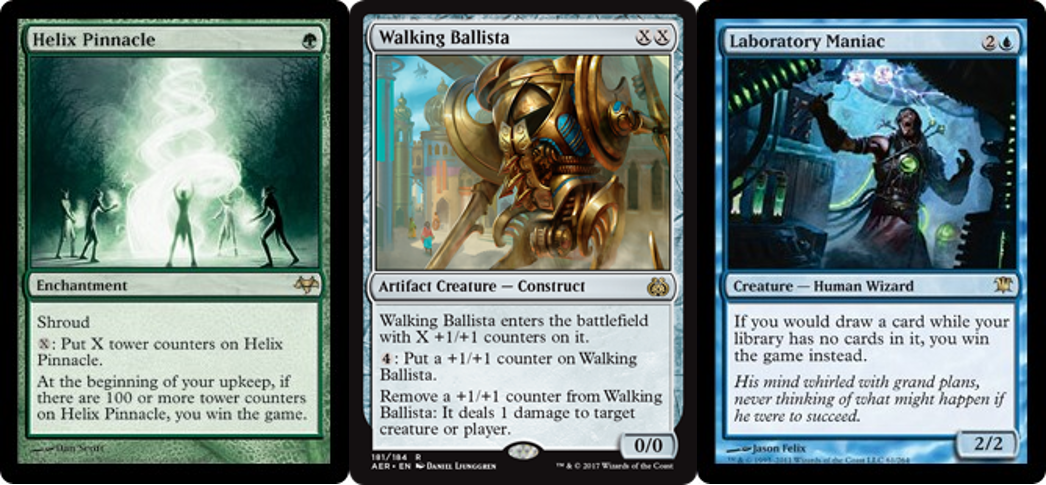
Our best and most convenient mana sink is Thrasios, Triton Hero. Being one of our commanders, we will always have access to him, and once we have infinite mana he will allow us to draw our entire deck. This will let us find any of our potential win conditions: Laboratory Maniac, Psychosis Crawler, Helix Pinnacle, or Walking Ballista. If for some reasons Thrasios is not available to us, Stroke of Genius will also allow us to draw our deck.
We don't necessarily need to draw our deck to win the game, however. Ballista and Helix are amazing mana sinks, and with infinite mana, both have the potential to end the game in short order.
Finally, if we have a means of generating infinite U mana or filtering the mana we make with Kydele (via Gemstone Array or Magus of the Candelabra) we can completely wipe our opponents' boards with Capsize.
Value from the Pieces
One of the advantages of having mana sinks as our primary win conditions is that they give us something to do when we don't have an infinite interaction in sight. Ballista is a great card overall, and we an load it with all the mana we're making from our ramp. This can help us keep some of the heat off our back by threatening to gun down any creatures sent our way. Pinnacle isn't an exciting card on its own, but we can slowly start filling it up in case we aren't ever given the opportunity to combo. And Array allows us to effectively store our mana from turn to turn.
Once again, Thrasios is the king of this category, as investing our mana into drawing cards and playing lands is never a bad thing.
From Point A to Point B
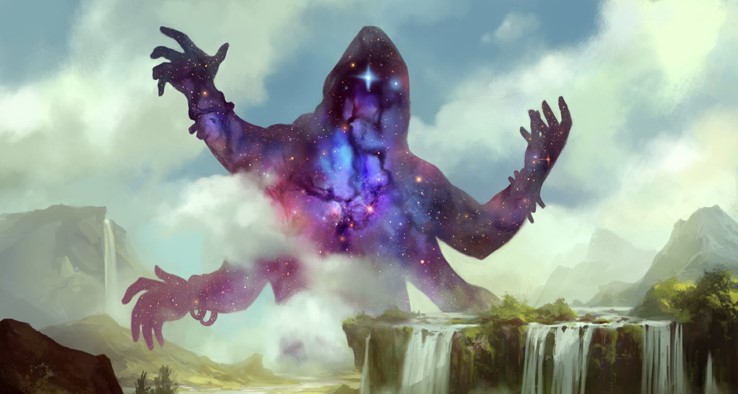
In response to my previous article, Jason Alt brought up an excellent point about the linearity of this style of deck. A very combo-focused deck that so readily has access to its combo pieces will be inclined to win similarly from game to game, and this can become boring to some players and play groups. Even if we consider the alternate combos I've built into this deck, the general formula is the same: make infinite mana -> pump mana into a mana sink -> win.
For some players, myself included, the fun of a deck like this is putting together a combo based on a handful of pieces, and trying to play around our opponents' potential answers. But if this doesn't sound appealing to you, there are a lot of neat directions we can take this deck to make it more interactive.
I've spent this series focusing on making a more efficient combo, but outside of combo Kydele is very good at producing loads of colorless mana. As Michael Lloyd pointed out in the comments to part 1, you could easily put this mana towards casting big Eldrazi, or big artifacts. For a deck aiming to cast big colorless fatties, Kruphix, God of Horizons would allow us to build up our mana from turn to turn, while being a super flavorful inclusion.
My previous iteration also included cards like Howling Mine and Dictate of Kruphix. This deck could easily be skewed towards "Group Hug", as Kydele appreciates all the extra cards drawn, and you would be able to pump the mana into sinks or fatties.
Any of these directions could still include some combo elements with the understanding that combo is not the primary goal of the deck.
The End (Game) is Nigh
I would like to thank you all for tuning in to another to another series of The Knowledge Pool. It's been a blast putting these articles together, and I really appreciate you taking the time to read them.
I hope I've encouraged you to consider playing a combo deck in your Commander group, and I hope I've piqued your interested in Kydele as a commander.
Next time, I'm planning to make some tokens... Some fat tokens..
Until then, I wish you all the best, and happy brewing!
Your opinions are welcome. We love hearing what you think about Magic! We ask that you are always respectful when commenting. Please keep in mind how your comments could be interpreted by others. Personal attacks on our writers or other commenters will not be tolerated. Your comments may be removed if your language could be interpreted as aggressive or disrespectful. You may also be banned from writing further comments.
